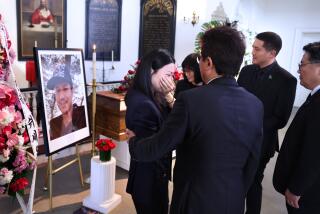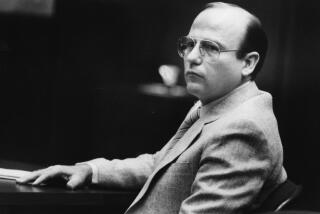‘Peace Officer’ documentary looks at why police tactics seem to be getting more brutal
When police killed his son-in-law in 2008, William “Dub” Lawrence, a retired lawman with a meticulous streak, started his own investigation, tracking bullet trajectories and scouring the crime scene in an obsession aimed at exposing the increased militarization that has turned many police forces into small armies.
Lawrence is the persistent everyman of “Peace Officer,” a documentary that examines excessive force at a time when police tactics nationwide have been criticized by government officials and civil rights groups. Much of the film’s focus is on the heavily armed SWAT teams that emerged after the 1965 Watts riots. They were central to the 1980s war on drugs, and their role expanded in recent years as the Defense Department has given military hardware to law enforcement agencies to combat terrorism.
Lawrence watched this dangerous evolution from his home in Davis County, Utah, where as sheriff he started a SWAT team in the 1970s that decades later was involved in a standoff that killed his son-in-law Brian Wood, who was sitting in a pickup truck with a handgun. Wearing gas masks and paramilitary gear, police closed in and fired 111 rounds, including tasers, pepper balls, flash-bang grenades and live ammunition.
SIGN UP for the free Indie Focus movies newsletter >>
“It’s a video games mentality,” said Lawrence, a private investigator who also runs a sewage pump repair business, in an interview. “Police are the good guys, civilians the bad guys. There’s a bully mentality.... They feel the badge and the gun give them omnipotent power.” He added: “Everybody learns how to kill, but there’s not much emphasis on neutralizing or negotiating.”
“Peace Officer,” which opens Friday in Los Angeles, was directed by Scott Christopherson and Brad Barber. The narrative follows Lawrence as he investigates Wood’s death and other cases, including the arrest of Matthew Stewart, an Army veteran and marijuana grower charged with killing a police officer and wounding five others during a nighttime raid at his home in Ogden, Utah. Stewart, who hanged himself in prison, believed the raid by plainclothes officers was a robbery and defended himself.
Lawrence recovered 54 bullets from the scene and concluded that one wounded officer was likely shot in the confusion by a fellow officer, not Stewart. As with Wood’s death, Lawrence said, miscalculations and aggressiveness by police led to unnecessary violence. That assertion is vividly illustrated as Lawrence re-enacts the fatal night in a clip that shows a web of dozens of yellow and red threads — each one representing a bullet trajectory — crisscrossing Stewart’s home.
Truth, not blame
Like a dogged sheriff in an old western, Lawrence, who as a young officer made local news for giving himself a parking ticket, is looking for truth, not blame. He has turned a small airplane hangar into a crime lab with thousands of pictures, documents and pieces of evidence. It is a discomfiting sanctuary where a man’s obsession collides with larger questions over constitutional rights and the power of police to protect.
The film originated after Christopherson, an assistant film professor at St. Edward’s University in Austin, Texas, met Lawrence at a softball game and visited the hangar. “It was a stranger than fiction story,” said the director. The Hollywood Reporter called “Peace Officer” a “powerful and important film about policing tactics that have crept into everyday use with little scrutiny.” Variety calls it “engrossing and well crafted as it is timely.”
The film traces how SWAT teams were subsumed by local police departments and mythologized in popular culture, including the 1970s TV show “S.W.A.T.” As Americans, notably in minority communities, grew accustomed to officers wearing Army-style helmets and fatigues, SWAT raids nationwide, many of them serving warrants for drug crimes, increased by 15,000% from the 1970s to today, according to the film.
President Obama said in May that the federal government would limit a federal program that provides military equipment, which has included grenade launchers, M-16 rifles, silencers and armored personnel carriers, to local police departments. A report last year by the American Civil Liberties Union found that the Defense Department transferred at least $4.3 billion of military hardware to police forces since the 1990s.
Obama said such gear can “alienate and intimidate residents and make them feel scared.”
“Peace Officer” is sensitive to the dangers police encounter from well-armed criminals. One Utah county police commander dismisses the notion that police are overly aggressive. “The reality is,” he says, “SWAT teams save lives.” Mistrust between police and black communities, however, has deepened since the protests and violence in Ferguson, Mo., last year. Police officers have been targeted and killed in recent months in Texas, Mississippi and Louisiana.
The police’s version
Christopherson and Barber, an associate film professor at Brigham Young University, said they were adamant about airing the police versions of what occurred in the cases Lawrence was investigating. Some officers were skeptical of how they’d be portrayed but a number of them appear in the film. “My grandfather was in the FBI for 25 years in Utah,” said Christopherson. “I have deep respect for law enforcement. It was really important for us that they have a voice and were not thrown under the bus.”
Lawrence, though, asks troubling questions about what he sees as the immunity and wide latitude given to police by prosecutors if officers feel their lives are in danger. “Everything’s wrong with that,” Lawrence said in an interview. “There’s no way to judge or challenge anybody’s feelings.”
A study done by Philip Stinson, a criminologist at Bowling Green State University, found that 41 on-duty police officers were charged with manslaughter or murder from 2005 to 2011. In the same span, the FBI recorded at least 2,700 justifiable homicides by police.
Lawrence also raises the specter of police incompetence and coverup. In the Stewart case, Lawrence said he found 54 bullets left at the scene long after police had investigated. He suggested that police possibly knew the evidence would have shown that one of the officers was shot by friendly fire, so they left it, increasing the chances that it would be contaminated and considered not admissible in court.
The Salt Lake Tribune criticized the police handling of the case: “The lives of one police officer and, indirectly, one other human being were lost due to the decision … to conduct a military style attack on a small-time weed grower.”
In the case of Lawrence’s son-in-law, officials said Wood, who provoked the standoff after assaulting his wife, committed suicide as police moved in after a long siege. Lawrence’s investigation showed that Wood was shot by a sniper as he lay immobilized on the ground with no weapon in his hand. The police retracted the suicide story, but a wrongful death suit filed by Wood’s family was dismissed.
“We need more transparency, we need more accountability,” said Lawrence. “But more important than anything is that national issue of equality under the law. When certain people in our society can break the law with impunity and regular citizens are required to obey the law, there is a disparity there that has to be addressed.”
Lawrence seems a man alone, painstakingly poring over files and binders of redacted pages. Hundreds of photographs line his hangar walls. He is patient, undeterred, examining bullet slugs and imagining, like a choreographer, how a shooting went down. When he needs to escape the stress, he flies his single-engine plane over the Great Salt Lake. He sometimes lands on remote islands and remembers when he was a young sheriff many years ago.
“I am obsessed with the idea of a police officer being a trusted friend, a qualified, trained peacemaker.”
Twitter: @JeffreyLAT
More to Read
Only good movies
Get the Indie Focus newsletter, Mark Olsen's weekly guide to the world of cinema.
You may occasionally receive promotional content from the Los Angeles Times.







